John William Hill (1812-1879) stands as a significant, if sometimes underappreciated, figure in nineteenth-century American art. Born in London, England, he immigrated to the United States with his family, eventually becoming a pivotal artist in the American Pre-Raphaelite movement. His meticulous attention to detail, profound love for the natural world, and mastery of watercolor established him as a unique voice, bridging the traditions of English landscape art with the burgeoning artistic identity of America. Hill's legacy is marked by his exquisite renderings of landscapes, still lifes, and ornithological subjects, all imbued with a scientific precision and a poetic sensibility.
Early Life and Artistic Foundations
John William Hill was born in London on January 13, 1812, into a family already steeped in artistic tradition. His father, John Hill (1770-1850), was a respected English aquatint engraver known for his skill in translating watercolors into prints. This familial environment undoubtedly provided the young Hill with early exposure to artistic techniques and the world of visual representation. The elder Hill's work, particularly his landscape engravings, would have offered a foundational understanding of composition and the rendering of natural forms.
In 1819, when John William was just seven years old, the Hill family made the significant decision to immigrate to the United States. They initially settled in Philadelphia, a city with a burgeoning cultural scene, before eventually moving to New York City. This transatlantic move placed the young artist in a new environment, one that would profoundly shape his artistic vision and subject matter. He received his initial artistic training directly from his father, learning the intricacies of drawing and engraving, which instilled in him a discipline for precision and detail from an early age.
By the age of seventeen, John William Hill was already demonstrating considerable talent and ambition. He began exhibiting his works, primarily watercolors and lithographs, at prominent venues such as the Brooklyn Art Association and the prestigious National Academy of Design in New York. This early recognition signaled the arrival of a promising new artist on the American scene, one whose technical proficiency was already evident.
A Cartographer's Eye: Early Career and Topographical Works
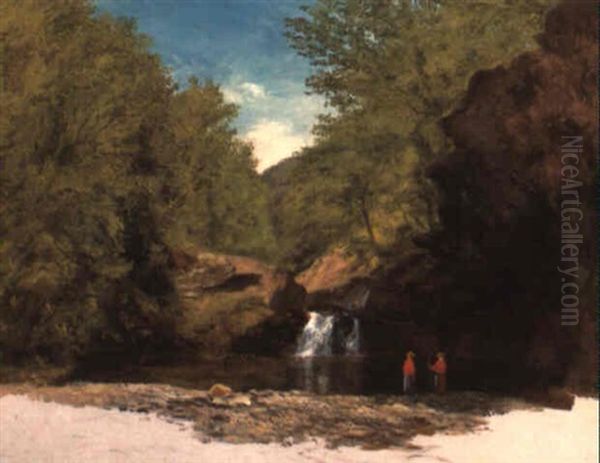
In his twenties, John William Hill's career took a practical turn that would further hone his skills in detailed observation and accurate rendering. He secured employment with the New York State Geological Survey. In this capacity, he was tasked with creating a series of topographical studies and panoramic city views. These commissions required an almost scientific exactitude, demanding precise depictions of terrain, urban layouts, and architectural features.
His work for the Geological Survey is particularly noted for its remarkable "aerial" perspectives, offering sweeping vistas of towns and landscapes. These views were not merely functional maps but artistic achievements in their own right, characterized by an astonishing level of detail, capturing even minute architectural elements with clarity. This experience in topographical art undoubtedly reinforced his commitment to accuracy and provided him with a unique understanding of landscape structure.
Beyond his governmental work, Hill also undertook commissions for private firms. He created numerous watercolor landscapes of American cities for the Smith Brothers publishing company of New York. Among these were views of burgeoning urban centers, including a notable depiction of New Orleans. These cityscapes combined his topographical precision with an emerging aesthetic sensibility, capturing the character and atmosphere of these growing American metropolises. This period laid a crucial groundwork for his later, more personal explorations of nature.
The Ruskinian Revolution: Embracing Pre-Raphaelitism
A significant turning point in John William Hill's artistic development occurred in the 1850s with his encounter with the writings of the influential English art critic and social thinker, John Ruskin. Ruskin's multi-volume work, "Modern Painters," which championed the art of J.M.W. Turner and advocated for a "truth to nature" approach, profoundly impacted Hill. Ruskin urged artists to reject academic conventions and to study the natural world with intense, almost religious, devotion, rendering its forms with meticulous fidelity.
Hill was deeply receptive to Ruskin's ideas. He began to move away from the more generalized, picturesque conventions that often characterized landscape painting of the era. Instead, he embraced a style of naturalism that emphasized direct observation and the precise depiction of botanical and geological detail. This shift aligned him with the principles of the Pre-Raphaelite Brotherhood, a group of English painters, poets, and critics founded in 1848 by William Holman Hunt, John Everett Millais, and Dante Gabriel Rossetti, who sought to emulate the art of Italian painters before Raphael.
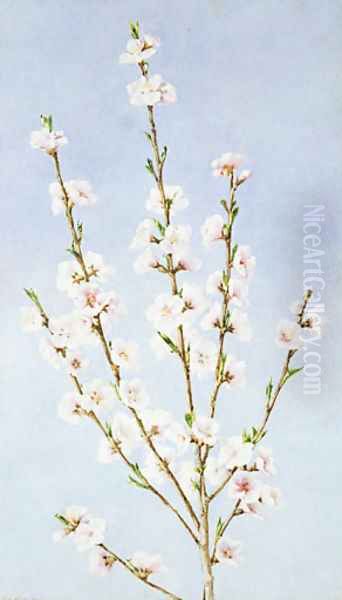
Inspired by Ruskin, Hill became a fervent advocate for these principles in America. He is now widely considered one of the leading figures, if not the foremost leader, of the American Pre-Raphaelite movement. This movement, though smaller and less cohesive than its British counterpart, shared the same core tenets: a rejection of idealized academic art in favor of a detailed, almost scientific, realism based on close observation of nature.
The American Pre-Raphaelite Circle
John William Hill was not alone in his Ruskinian fervor. He became a central figure in a circle of like-minded American artists who also embraced the call for "truth to nature." This group, sometimes referred to as the American Pre-Raphaelites or the "Association for the Advancement of Truth in Art," sought to reform American art by promoting these ideals. Hill served as the president of this association, which published the influential journal "The Crayon" (though "The New Path" is more directly associated with the stricter American Pre-Raphaelites). "The Crayon," edited by William James Stillman and John Durand (son of Asher B. Durand), was instrumental in disseminating Ruskin's ideas in America.
Key figures associated with or influenced by American Pre-Raphaelitism, alongside Hill, included William Trost Richards, who, like Hill, produced incredibly detailed landscapes and marine studies. Thomas Charles Farrer, an Englishman who came to America, was another staunch advocate and practitioner of Ruskinian principles, known for his meticulous still lifes and landscapes. Other artists who demonstrated Pre-Raphaelite tendencies in their work included Charles Herbert Moore, who later became a professor of art at Harvard, Henry Roderick Newman, known for his detailed architectural and floral watercolors, and Fidelia Bridges, celebrated for her delicate depictions of birds and flowers.
These artists shared a commitment to working directly from nature, often outdoors (en plein air), and to rendering their subjects with the utmost precision. They believed that by faithfully transcribing the details of the natural world, they could reveal a deeper, spiritual truth. Hill's leadership and his own exemplary work provided a powerful model for this burgeoning movement in the United States.
Artistic Style: Meticulous Detail and Luminous Watercolor
John William Hill's mature artistic style is characterized by its extraordinary meticulousness and his preferred medium, watercolor. He developed a distinctive technique, often employing stippling—the application of paint in tiny dots or short strokes—using miniature brushes. This painstaking method allowed him to achieve incredibly fine gradations of tone and color, and to render the most intricate details of foliage, rock formations, feathers, and flower petals with astonishing clarity.
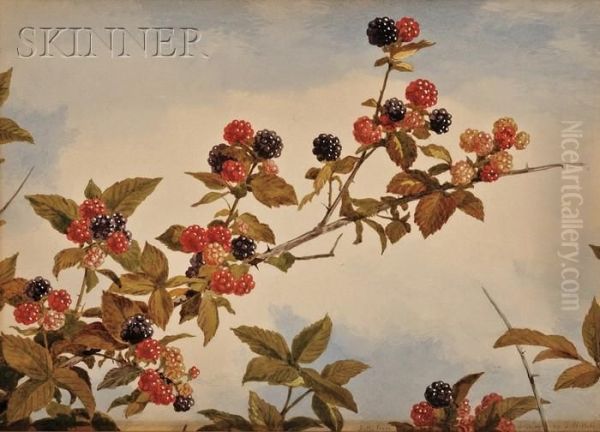
His watercolors are luminous, with a clarity and brilliance of color that captures the vibrancy of the natural world. Unlike the broader, more atmospheric effects sought by many Hudson River School painters like Sanford Robinson Gifford or Albert Bierstadt, Hill's focus was on the specific and the tangible. His landscapes are not grand, idealized panoramas in the vein of Frederic Edwin Church, but rather intimate, closely observed studies of particular places or natural elements.
The influence of J.M.W. Turner, championed by Ruskin, can also be discerned in Hill's work, particularly in his handling of light and atmosphere, though Hill's application was generally more controlled and less overtly dramatic than Turner's. Hill's commitment was to an objective, almost scientific, realism, yet his works are far from sterile. They possess a quiet poetry and a palpable sense of wonder at the beauty and complexity of creation. His approach was a direct response to Ruskin's call to "go to Nature in all singleness of heart... rejecting nothing, selecting nothing, and scorning nothing."
Masterworks of Observation: Key Paintings and Themes
John William Hill's oeuvre encompasses a range of subjects, primarily landscapes, still lifes, and detailed studies of birds and plants. His landscapes often depict specific locales in the American Northeast, rendered with his characteristic precision. "View of the Erie Canal," for example, showcases his ability to combine topographical accuracy with a serene, harmonious depiction of a man-made structure integrated into the natural environment. "Fawn's Leap" (1864), a watercolor, captures the rugged beauty of a woodland scene with an intense focus on the textures of rocks, water, and foliage.
His still life paintings are equally remarkable for their fidelity. Works like "Peach Blossoms" (1874), "Apple Blossoms" (ca. 1874), and "Blackberries" (1875) are exquisite examples of botanical accuracy. Each petal, leaf, and berry is rendered with such care that the viewer feels they could almost touch them. "Thistles" (ca. 1865) demonstrates his ability to find beauty even in humble subjects, elevating them through intense observation. These works are not merely decorative; they are profound meditations on the intricacies of natural forms.
Hill was also an accomplished ornithological painter. His studies of birds, often depicted in their natural habitats or with their nests, are masterpieces of detailed observation. These works reflect a deep knowledge and appreciation of avian life, combining scientific accuracy with artistic sensitivity. His dedication to capturing the precise plumage and characteristic poses of different species is evident in these delicate watercolors.
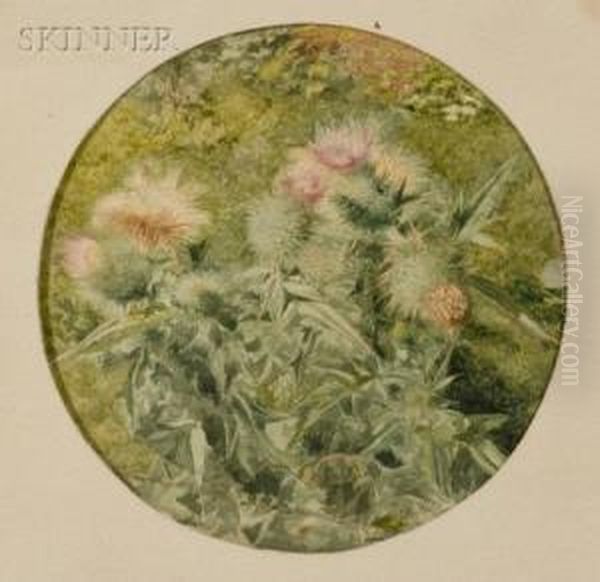
Other notable works include "The Palisades" (ca. 1871), a depiction of the dramatic cliffs along the Hudson River, and "View from High Tor, Haverstraw, New York" (ca. 1866), which showcases his skill in rendering expansive views with detailed foregrounds. "Mountain Stream" is another example of his intimate landscapes, focusing on the play of light on water and the textures of rocks and vegetation.
Collaborations and Artistic Circles
John William Hill's artistic journey was shaped not only by influential thinkers like Ruskin but also by direct collaborations and interactions with other artists. His father, John Hill Sr., was his first teacher and a significant influence, particularly in the realm of printmaking. The elder Hill was renowned for his aquatint engravings for important early American print series, including "Picturesque Views of American Scenery" (from drawings by Joshua Shaw) and William Guy Wall's "The Hudson River Portfolio." John William Hill himself contributed to some of his father's later projects, gaining invaluable experience in the collaborative world of print production.
His association with Joshua Shaw (c. 1777-1860), an English-born landscape painter who also immigrated to America, was significant. Shaw was a key figure in early American landscape art, and Hill's father engraved many of Shaw's designs. This connection likely exposed the younger Hill to prevailing landscape conventions, even as he later forged his own distinct path.
While Hill's Pre-Raphaelite approach set him apart from the mainstream Hudson River School, he was a contemporary of its leading figures, such as Thomas Cole, Asher B. Durand, Frederic Edwin Church, and Albert Bierstadt. Though their artistic philosophies differed in emphasis—the Hudson River School often favoring grander, more romantic, and sometimes idealized visions of the American wilderness—they shared a common interest in the American landscape as a primary subject for art. Hill's meticulous, scientific approach offered a different, but equally valid, way of engaging with and interpreting that landscape.
His involvement with the Association for the Advancement of Truth in Art brought him into close contact with other American Pre-Raphaelites like William Trost Richards, Thomas Charles Farrer, and Charles Herbert Moore, fostering a community of artists dedicated to similar ideals. This network provided intellectual and artistic support, crucial for a movement that often ran counter to prevailing academic tastes.
Exhibitions and Institutional Recognition
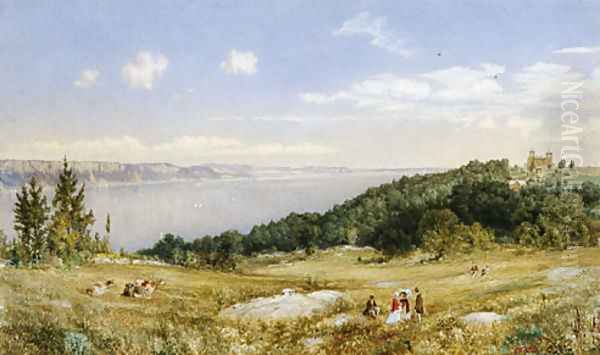
Throughout his career, John William Hill actively exhibited his work, gaining recognition in prominent artistic circles. He was a regular exhibitor at the National Academy of Design in New York, a key institution for American artists, and also showed his work at the Brooklyn Art Association. These exhibitions provided platforms for his art to be seen by the public and by fellow artists, contributing to his reputation as a master of watercolor and a leading proponent of Pre-Raphaelite principles.
His works were featured in significant exhibitions, including "The American Pre-Raphaelites: Radical Realists," a modern survey that highlighted his contributions. Specific pieces like "Peach Blossoms," "Apple Blossoms," and "Afterglow" (ca. 1875) were showcased in such contexts. His painting "Thistles" was exhibited at the Winter Antiques Show, and "Fawn's Leap" at TEFAF New York through Thomas Colville Fine Art. "Blackberries" was shown at The American Art Fair.
Today, John William Hill's artworks are held in the collections of major American museums, a testament to their enduring quality and historical importance. The Metropolitan Museum of Art in New York owns works such as "The Palisades." The Brooklyn Museum holds "View from High Tor, Haverstraw, New York." Other institutions with his art include the Museum of Fine Arts, Boston; the New-York Historical Society (which has "Mount Washington from Shelburne, New Hampshire"); the Princeton University Art Museum; the Peabody Essex Museum in Salem, Massachusetts; and the Field Museum of Natural History in Chicago, which possesses a significant collection of his bird watercolors.
The Hill Family Legacy
The artistic inclinations of the Hill family did not end with John William. His father, John Hill Sr., had already established a reputation as a skilled engraver. This artistic lineage continued with John William's own son, John Henry Hill (1839-1922). John Henry Hill followed in his father's footsteps, also becoming an artist, particularly noted for his watercolors and etchings, and embracing the Pre-Raphaelite principles championed by his father.
John Henry Hill worked closely with his father and was deeply influenced by his meticulous style and dedication to nature. He, too, was an admirer of Ruskin and sought to capture the natural world with detailed accuracy. The younger Hill also became known for his landscape paintings and etchings, continuing the family's contribution to American art. After his father's death, John Henry Hill compiled and published "An Artist's Memorial" in 1888, a tribute to John William Hill's life and work, illustrated with etchings of his father's paintings. This publication helped to preserve and promote his father's artistic legacy. This continuation of artistic practice across three generations underscores the deep-rooted creative environment within the Hill family.
Enduring Influence and Historical Assessment
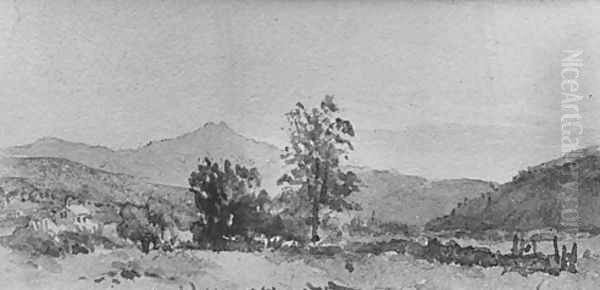
John William Hill passed away in West Nyack, New York, in 1879. While he may not have achieved the widespread fame of some of his Hudson River School contemporaries during his lifetime, his contribution to American art is undeniable and has gained increasing recognition from art historians. He is acknowledged as a pioneering figure in the American Pre-Raphaelite movement and one of the foremost watercolorists of his generation in the United States.
His unwavering commitment to "truth to nature," inspired by John Ruskin, offered a distinct alternative to the prevailing artistic conventions of the mid-nineteenth century. His meticulous technique, particularly his mastery of stippling in watercolor, allowed him to create works of extraordinary detail and luminosity. Whether depicting sweeping landscapes, intimate still lifes of fruit and flowers, or precise ornithological studies, Hill's art reveals a profound reverence for the natural world in all its complexity.
The academic world now regards John William Hill as one of America's most important early graphic artists and a key figure in the development of American landscape and still life painting. His influence extended through his own work, his leadership in the Association for the Advancement of Truth in Art, and through his son, John Henry Hill. His paintings and watercolors continue to be admired for their technical brilliance, their delicate beauty, and their earnest, almost spiritual, engagement with nature. John William Hill's legacy is that of an artist who, with quiet dedication and remarkable skill, sought to capture the intricate truths of the world around him.